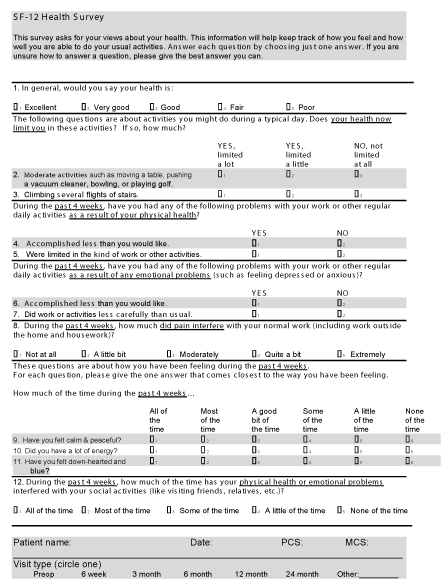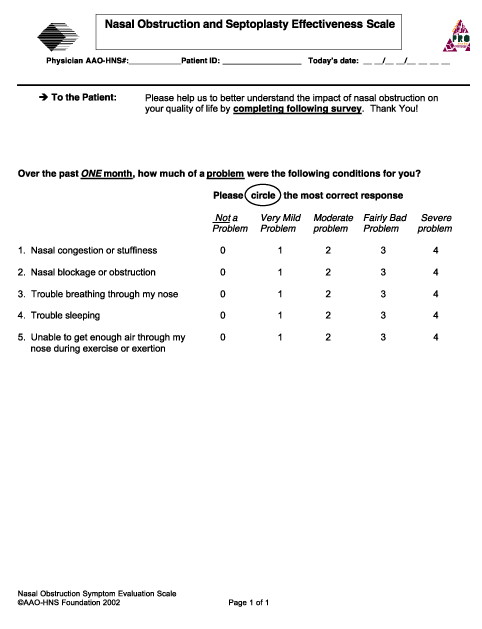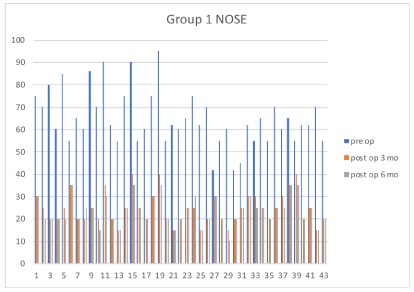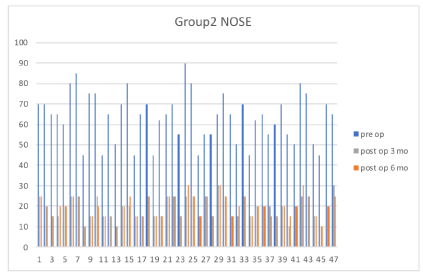Archives of Otolaryngology and Rhinology
Short term subjective outcomes of lateral fracture as a complementary treatment of coblation turbinoplasty in traumatized nose
Pier Giorgio Giacomini*, Francesco Maria Passali, Barbara Flora, Valentina Rosati and Stefano Di Girolamo
Cite this as
Giacomini PG, Passali FM, Flora B, Rosati V, Girolamo SD (2019) Short term subjective outcomes of lateral fracture as a complementary treatment of coblation turbinoplasty in traumatized nose. Arch Otolaryngol Rhinol 5(1): 026-030. DOI: 10.17352/aor.000091Inferior turbinate compensatory hypertrophy is a common condition found in post-traumatic septal deviation. In literature several approaches are described for treating turbinates enlargment. We conduct a retrospective study on two group of 43 and 48 patients mached for age and sex that underwent to rino-septo-turbinoplasty from January 2011 to January 2013. First group was treated by inferior turbinates submucous unipolar coblation and the second by submucous unipolar coblation plus lateral outfracture. Inclusion criteria were: isolated nasal occlusion non-sensitive to medical treatment with compensatory enlarged inferior turbinate/s and marked nasal pyramid-septal deviation evaluated by pre-operative nasal endoscopy; turbinates hypertrophic grade from I –III according to Friedman.
“Functional” results were graded by subjective pre- and post-operative evaluation (3 and 6 months after surgery) using SF–12 and NOSE scoring systems. Turbinate volume reduced significantly (CHI square test, p<0.001) post-operatively. Grade III score from more than 1/3 of patients pre-op falls to none post-op (p<0.001). Grade II reduces from 58% to 23%. Grade I sharply increase from none pre-op to 72% post-op. These data remain grossly unchanged at 6 months endoscopy. 69/91 (83%) patients were satisfied by surgical results on nasal breathing checked by SF-12 (p < 0.01) at 3 and 6 months post-operatively.
The NOSE pre-operative scoring reduced significantly post-op. (65.6 vs 22.8, p< 0.001), early and late post-op results are similar but an increase of scores is recorded overtime.
No significant (over one minute) lengthening of surgical time was ever recorded due to the lateral outfracture of the conchal bone. A wider nasal passage by nasal endoscopy after coblation plus outfracture vs simple coblation was observed but the NOSE scores improved similarly in both groups.
The lateral outfracture of the turbinate may improve the volume of air passage through the nose without increasing of complication rates or healing time.
Introduction
Nasal obstruction represents one third of the complaint symptoms that induce a patient to Ent specialists [1]. Main cause of nasal obstruction is turbinate hypertrophy that may be due to different aetiologies such as anatomical, physiological or pathophysiological causes. Allergic and nonallergic rhinitis are the most common noninfectious causes of inferior turbinate mucosal swelling, leading to a transient reduction of nasal patency. Many cases improve the nasal obstructive symptomatology with topical corticosteroids, antihistamines, or immunotherapy. In other cases, these nasal inflammatory processes result a dilatation of the venous sinuses or fibrosis with a non-effectivity of medical therapy [2]. In traumatic septal deviation, a common condition is inferior turbinate compensatory hypertrophy [3]. This condition is not only caused by mucosal enlargement, but also by bony hypertrophy of the inferior turbinate itself [4]. Despite the common use of the terms “turbinate hypertrophy” there’s no evidence of cellular hypertrophy and this manifestation should be indicated with the more correct definition of 'turbinate enlargement' [5]. Deviation of the nasal septum toward one side determine an overgrowth of the inferior turbinate to occupies the expansive space of the contralateral nasal cavity, in order to protect the more patent nasal side from excess airflow with its drying and crusting effects. This situation has important implications for the surgical management of nasal obstruction. No uniform consensus exists about the best way to achieve surgical turbinate reduction. Up to 13 different methods of reductive turbinoplasty have been introduced up-to-date and some discarded or modified overtime. The technique to obtain volumetric reduction of the turbinate avoiding damage of the mucosal layer is still debated [6]. The differences underlined in discussions dealing with turbinates treatment focus mainly on the “hypertrophic” mucosa and cavernous tissue underneath. Aim of the present paper is to evaluate the short term outcome of inferior turbinate’s treatment in a cohort of patients submitted to rhino-septo-turbinoplasty for long-term nasal trauma, evaluating the Coblator turbinoplasy with/without conchal bone-plasty, obtained by lateral outfractures.
Material and Methods
Patients
Inclusion criteria were: isolated nasal occlusion non-sensitive to medical treatment with compensatory enlarged inferior turbinate/s and marked nasal pyramid-septal deviation evaluated by pre-operative nasal endoscopy; turbinates’ hypertrophic grade from I (slightly occluding) – III (totally occluding the nasal fossa) according to Friedman [7]. Sino-nasal different pathologies were excluded by history, nasal endoscopy and CT scan (if felt necessary according to the history and physical examination).
Pre-operative CT scan of the nasal fossae was available in 38 patients to rule out sinus pathology and to assess the bony/soft tissues component of the hyperplastic inferior turbinates.
“Functional” results were graded by subjective pre- and post-operative (3 months and 6 months after surgery) patient’s self-evaluation of general health status by SF–12 (Figure 1) and nose-related health status by NOSE scoring systems (Figure 2).
The SF-12 test is useful to monitor the health status of a population and derives from SF-36 questionnaire, and is based on 12 multiple choice questions regarding 8 “dominons”. The record is regarding the physical index (PCS) and mental index (MCS) status.
Anatomical results were based on surgeon’s pre- and post-operative (3 and 6 months after surgery) grading (I-III) of turbinates at nasal endoscopy (by a surgeon not involved in the surgical procedure to avoid possible bias).
Statistical analysis
Statistical analysis was carried out by paired and two group Wilcoxon tests (pre-op and post-op SF-12 scores), Student T-test (pre-op and post-op NOSE scores) and chi-square test (pre-op and post-op Friedmann grading scores).
This study was approved by the institutional review board.
Surgical technique
Standard subpericondral-periosteal septoplasty and Coblation inferior turbinate reduction with/without lateral outfractures was carried out under general plus local sub-mucous anesthesia of the septum and turbinates (2% Lidocaine+ 1:100.000 Epineprine, 5 ml syringe by 1.5 inch-long, 27 Gauge needle) as inpatient procedure. The Coblator nasal probe was inserted starting from the anterior 1/3 of the turbinate up to the posterior 1/3 developing 3-4 submucosal tunnels until a visible shrinking/whitening of the surface was seen under endoscopic control.
Lateral outfractures were encompassed by n.2 Cottle osteotome reversed and used as blunt, flat dislocator positioned along the turbinate and laterally pushed to displace the bony component until a cracking noise was felt. Differently from other described procedures [8], we did not use a long-bladed Killian speculum or large clamp in a spreading fashion nor exerted a cantilever movement of the dislocator against the nasal septum. Avoidance of any damage to the septal mucosa, possibly leading to septo-turbinal synechiae formation, was felt maximized by such a hint. Post-operative very soft non-adehering nasal packing (Vaseline gauze 2x1-inch pledgets) was kept in place for 48 hours. Standard nasal fossae saline irrigation and antibiotic ointment were administered for the next 4 weeks.
Results
No major intra or post-operative complications were recorded at follow-up.
69/91 (83%) patients were satisfied by surgical results on nasal breathing. SF-12 reveled significant improvement of both Physical Index (PCS: 46.1 pre-op. vs. 53.4 post-op.) and Mental Index (MCS: 41.1 pre-op vs. 58.7 post-op.) (p < 0.01) 3-6 months post-operatively and 2 years post-operatively (MCS: 41.1 pre-op vs. 57.2 post-op.) (PCS: 45.1 pre-op vs 53.6 post-op) (p<0.01) (Table 1).
Mean NOSE scores are summarized in table 2, analytical results are depicted in figure 3,4. Briefly the pre-operative scoring reduced significantly post-op. (65.6 vs 22.8, p< 0.001), early and late post-op results are similar but an increase of scores is recorded overtime.
Objective evaluation of turbinate size is reported in table 3, turbinate volume reduced significantly (CHI square test, p<0.001) post-operatively. Grade III score from more than 1/3 of patients pre-op. falls to none post-op (p<0.001). Grade II reduces from about 58% to 23%. Grade 1 sharply increase from none pre-op to 72% post-op. These data remain grossly unchanged at 6 months endoscopy.
In several cases in the senior author experience the lateralization allowed better exposure and treatment of turbinate tail moriform degeneration otherwise hard to expose and treat.
Complication rates reported in Table 4 seem acceptable, temporary crusting being the preminent arising up to 25% of cases, no complications were still present beyond 5 weeks after surgery.
The mean operative time of turbinate decongestion with Coblator and lateral outfractures was 6 minutes instead of 5 minutes of decongestion using Coblator technique only. No significant (over one minute) lenghtening of surgical time was ever recorded due to the lateral outfracture of the conchal bone.
Discussion
Improving nasal function in patients affected by nasal obstruction unresponsive to medical therapy require a surgical approach on the septum and the turbinates most of the times. Potential complications may occur though using different turbinate reducing procedures [9], most of them are related to nasal mucosa permanent damage deriving from exceedingly aggressive surgical strategies.
Studies comparing different modalities of turbinate treatment are very rare and studies that meet all the criteria of a prospective comparative surgical study are exceptions [10].
Preservation is the goal of actual turbinate treatment: well-known surgical procedures are too aggressive causing mucosal damages, post-operative complications and discomfort for patients [11]. Intraturbinal reduction (intraturbinal turbinoplasty) would seem to be the best method to obtain a valid volumetric reduction avoidance of mucosal damages [12]. Coblation ('controlled ablation') was a quite recently introduced method of high frequency bipolar diathermy. As the effect is achieved at low temperatures, damage to the neighbouring tissue is said to be minimal [13]. Evidence exist that the use of Coblation for inferior turbinate hypertrophy and the clinical benefit are still evident at 6 months follow up [14]. In the present paper, we aimed to assess the usefulness of the association of an established procedure such as turbinate Coblation decongestion method with lateral outfractures as a complementary treatment in traumatized nose. Is wellknown that acoustic rhinomanometric value shown improvement after coblation technique [15]. So we decide to incentrate our analysis on the functional assessment of nasal breathing using SF-12 and NOSE that are a validated scoring means. Validated scoring is able to distinguish disease modalities and repeatability between ratings in the same patient (longitudinal validity) and between different patients (cross-sectional validity). These questionnaires, differently from simple symptom list, include also psyco-social aspects.
In the last two decades, more attention has been paid not only to the nasal symptoms, but also to the patient’s health-related quality of life by the Quality of life questionnaires (such as SF-12) [16]. It’s a reliable tool to assess nasal patency and a good way to evaluate the patient’s nasal subjective perception of the pathology as reported by Dolan [17].
Most of the results shows that despite the surgical method used the patients enjoy subjective persistent improvement of general and nasal symptoms as recorded by the validated scoring system (SF-12 and NOSE). At follow-up SF-12 results testify a statistically significant improvement of mental and physical general status while NOSE shows an improvement of nasal function in all patients. It means that a better nasal breathing improves the self-care and the physical, social and personal activities with reduced feelings of tiredness, pain or scant health (recorded by PCS) enhancing positive psychologic attitude without psychological and emotional discomfort (recorded by MCS) leading to a good overall health status.
Limitation of the presented data may derive from the retrospective study design, the means of results evaluation that do not take into account objective data such as rhinomanometry or acoustic rhinometry that may be employed to assess the respiratory patency.
It must be also mentioned that a longer follow up would be advisable reassessing the post-operative results after twelve- twenty four months after surgery.
Conclusion
In conclusion, our study compares the results of turbinate submucous reduction by Coblation with and without lateral outfractures as complementary treatment. This comparison between the only single Coblation treatment of the turbinates vs Coblation plus lateral displacement, specifically evaluated in post-traumatic nasal deformity is not mentioned in previous studies to our knowledge, therefore the presented paper seems the first to repost such as comparison.
Coblation determine significant shrinkage of the inferior conchae at 3 and 6 months follow up controls, according to the anatomical assessment of nasal turbinates hypertrophy endoscopically graded according to Friedmann. The reduction is improved by the lateral outfracture of the turbinate itself. This simple manuver reached better results and does not worsen the mucosal damage as testified by the low incidence of post-operative complications, these are never persistent beyond 4-5 weeks nor particularly bothersome to the patient. The time necessary for lateral outfracture does not exceed 1 minute [18] and the widen of the nasal fossae after the lateralization has been quantitatively demonstrate [19].
We recorded a wider nasal passage by nasal endoscopy after Coblation plus outfractures vs simple Coblation but the patient’s self-reported nasal symptoms (NOSE scores) improved similarly in both Coblation and Coblation plus outfractures groups. That different outcome evaluation can derive from the fact that patient evaluates his/her NOSE’s overall performances while the surgeon has a single-shot view of the anatomical situation of the nasal fossae during endoscopy, the latter may not be related to the nasal patency perception.
Finally, it must be underlined that often the lateralization of the turbinate gives a better surgical exposure of the posterior 2/3 of the turbinate allowing so a better control of these areas.
Based on the presented data, our experience in turbinate reduction by Coblation with and without lateral outfractures highlights the adjunctive impact of this manuver in improving nasal airway during submucosal conservative soft tissues treatment. The efficacy of Coblation turbinoplasty is confirmed and its positive impact on patient’s quality of life underlined. The lateral outfractures improve the nasal patency without increase of complication rates or healing time, nor significantly lengthening the procedure, therefore it seems a useful adjunct in surgeon’s armamentarium.
- Smith DH, Brook CD, Virani S (2018) The inferior turbinate: An autonomic organ. Am J Otolaryngol 39:771-775. Link: https://tinyurl.com/y5q3hvno
- Passali D, Lauriello M, Anselmi M (1999) Treatment of hypertrophy of the inferior turbinate: Long-term results in 382 patients randomly assigned to therapy. Ann Otol Rhinol Laryngol 108: 569-575. Link: https://tinyurl.com/y3ltw4tb
- Demir D, Asil K, Güven M (2015) Assessment of the correlation between nasal septal deviation and compensatory hypertrophy of the middle turbinate. Eur Arch Otorhinolaryngol 272: 2847-2851. Link: https://tinyurl.com/yxqhskzk
- Orhan I, Aydın S, Ormeci T (2014) A radiological analysis of inferior turbinate in patients with deviated nasal septum by using computed tomography Am J Rhinol Allergy 28: e68-72. Link: https://tinyurl.com/yxouqupq
- Passàli D, Passàli FM, Damiani V (2003) Treatment of inferior turbinate hypertrophy: a randomized clinical trial. Ann Otol Rhinol Laryngol 112: 683-688. Link: https://tinyurl.com/y3smm7fx
- Salzano FA, Mora R, Dellepiane M (2009) Radiofrequency, high-frequency, and electrocautery treatments vs partial inferior turbinotomy: microscopic and macroscopic effects on nasal mucosa Arch otolaryngol Head Neck Surg 135: 752-758. Link: https://tinyurl.com/y5ht38le
- Friedman M, Tanyeri H, Lim J (1999) A safe, alternative technique for inferior turbinate reduction. Laryngoscope 109: 1834-1837. Link: https://tinyurl.com/y4vvsfjy
- Bhandarkar ND, Smith TL (2010) Outcomes of surgery for inferior turbinate hypertrophy . Curr Opin Otolaryngol Head Neck Surg 18: 49-53. Link: https://tinyurl.com/yyktkhoz
- Dawes PJ (1987) The early complications of inferior turbinectomy. J Laryngol Otol 101: 1136-1139. Link: https://tinyurl.com/yy47edrv
- De Corso E, Bastanza G, Di Donfrancesco V (2016) Radiofrequency volumetric inferior turbinate reduction: long-term clinical results Acta Otorhinolaryngol Ital 36: 199-205. Link: https://tinyurl.com/yyq4n5eo
- Chen YL, Tan CT, Huang HM (2008) Long-term efficacy of microdebrider- assisted inferior turbinoplasty with lateralization for hypertrophic inferior turbinates in patients with perennial allergic rhinitis. Laryngoscope 118: 1270-1274. Link: https://tinyurl.com/y29vwytp
- Dhulipalla S (2015) Comparative Study of Response Through Reduction in the Size of Hypertrophied Inferior Turbinate Causing Nasal Obstruction by Different Surgical Modalities: A Prospective Study. Indian J Otolaryngol Head Neck Surg 67: 56-59. Link: https://tinyurl.com/y6k4xs6y
- Williams HO, Fisher EW, Golding-Wood DG (1991) Two-stage turbinectomy: sequestration of the inferior turbinate following submucosal diathermy. J Laryngol Otol 105: 14-16. Link: https://tinyurl.com/y46n9oo7
- Hol MKS, Huizing EH (2000) Treatment of inferior turbinate pathology: a review and critical evaluation of the different techniques. Rhinology 38: 157-166. Link: https://tinyurl.com/y4jguu7n
- Lee KC, Cho JM, Kim SK, Lim KR, Lee SY, et al. (2017) The Efficacy of Coblator in Turbinoplasty. Arch Craniofac Surg 18: 82-88. Link: https://tinyurl.com/y46rnl4c
- Bhattacharyya N, Kepnes LJ (2003) Clinical effectivness of coblation inferior turbinate reduction. Otolaryngol Head Neck Surg 129: 365-371. Link: https://tinyurl.com/y5z3cwde
- Haroon Y, Saleh HA, Abou-Issa AH (2013) Nasal soft tissue obstruction improvement after septoplasty without turbinectomy. Eur Arch Otorhinolaryngol 270: 2649-2655. Link: https://tinyurl.com/y2fsursv
- Dolan RW (2004) Endoscopic septoplasty. Facial Plast Surg 20: 217-221. Link: https://tinyurl.com/y66qmy7t
- Abou-Sayed HA, Lesavoy MA, Gruber RP (2007) Enlargement of nasal vault diameter with closed septoturbinotomy. Plast Reconstr Surg 120: 753-759. Link: https://tinyurl.com/y6a9k6jr
Article Alerts
Subscribe to our articles alerts and stay tuned.
 This work is licensed under a Creative Commons Attribution 4.0 International License.
This work is licensed under a Creative Commons Attribution 4.0 International License.





 Save to Mendeley
Save to Mendeley
